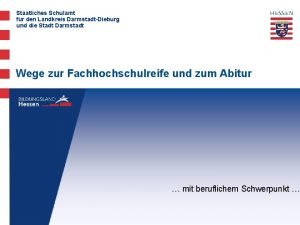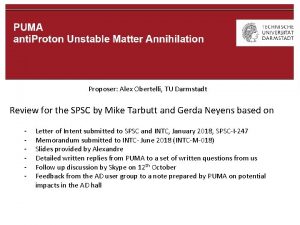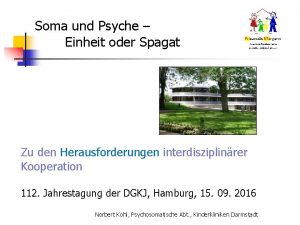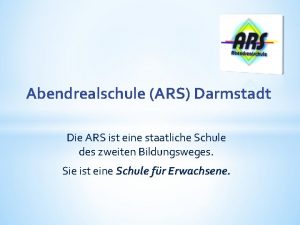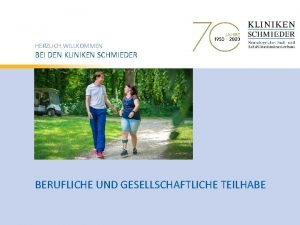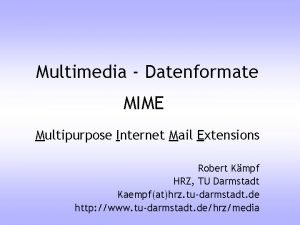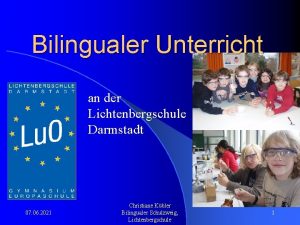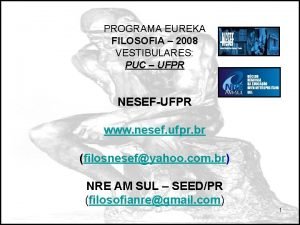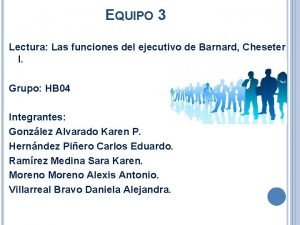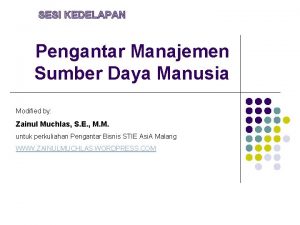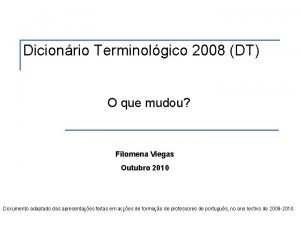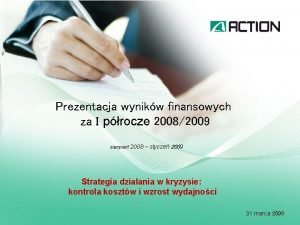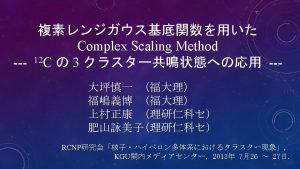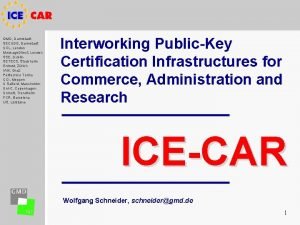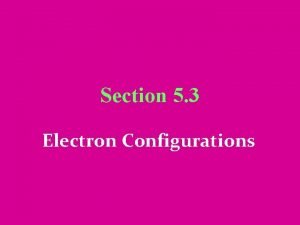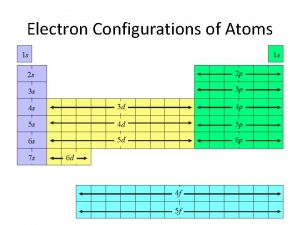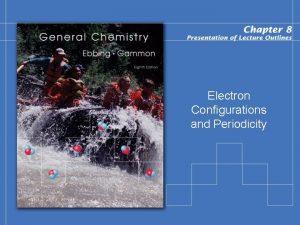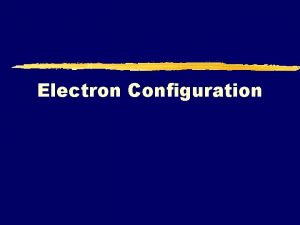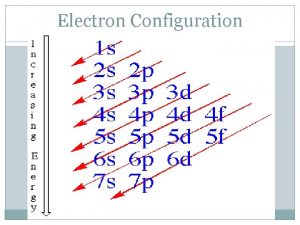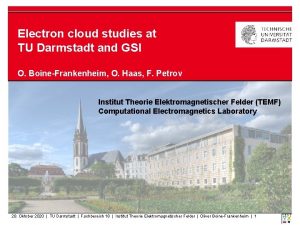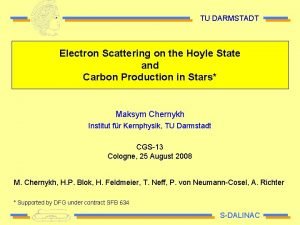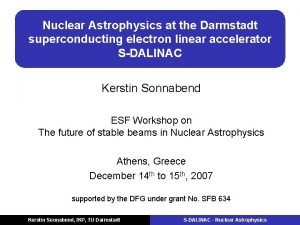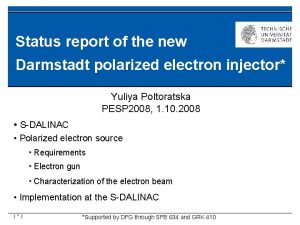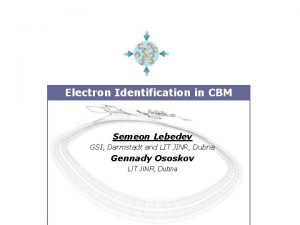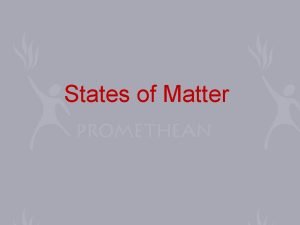Darmstadt 2008 TU DARMSTADT aCluster States in Electron





















- Slides: 21

Darmstadt 2008 TU DARMSTADT a-Cluster States in Electron Scattering * Maksym Chernykh Institut für Kernphysik, TU Darmstadt M. Chernykh 1, H. Feldmeier 2, T. Neff 2, P. von Neumann-Cosel 1, and A. Richter 1 Institut für Kernphysik, TU Darmstadt 2 Gesellschaft für Schwerionenforschung (GSI), Darmstadt 1 * Supported by DFG under contract SFB 634 S-DALINAC

Motivation: structure of the Hoyle state is a prototype of a-cluster states in light nuclei Cannot be described by shell-model approaches a-cluster models predict Hoyle state as a dilute gas of weakly interacting a particles resembling the properties of a Bose-Einstein Condensate (BEC) Comparison of high-precision electron scattering data with predictions of FMD and a-cluster models Hoyle state cannot be understood as a true Bose-Einstein Condensate ! M. Chernykh, H. Feldmeier, T. Neff, P. von Neumann-Cosel, and A. Richter, Phys. Rev. Lett. 98 (2007) 032501

Motivation: astrophysical importance http: //outreach. atnf. csiro. au Triple alpha reaction rate (a, a’) (p, p’) Reaction rate with accuracy ~ 6% needed S. M. Austin, Nucl. Phys A 758 (2005) 375 c (p, p’) (e, e’)

Motivation: astrophysical importance Crannell et al. (1967) Strehl (1970) Crannell et al. (2005) Total uncertainty Dr 3 a/r 3 a = 11. 6% only

Transition form factor to the Hoyle state Fourier-Bessel analysis: Crannell (2005) Extrapolation to zero momentum transfer: Crannell (1967), Strehl (1970) H. Crannell, data compilation

Model-independent PWBA analysis Model-independent extraction of the partial pair width

Monopole matrix element ME = 5. 37(22) fm 2, Rtr = 4. 24(30) fm Large uncertainty because of narrow momentum transfer region P. Strehl, Z. Phys. 234 (1970) 416

Lintott spectrometer

Detector system Si microstrip detector system: 4 modules, each 96 strips with pitch of 650 mm Count rate up to 100 k. Hz Energy resolution 1. 5 x 10 -4 10 cm

Measured spectra

Monopole matrix element

Triple alpha reaction rate Crannell et al. (1967) Strehl (1970) Crannell et al. (2005) Present work Total uncertainty Dr 3 a/r 3 a = 10% Only need to be improved

Summary and outlook – Hoyle state is important for stellar nucleosynthesis – Monopole matrix element can be extracted by extrapolation of cross section to zero momentum transfer – Gp for decay of the Hoyle state with uncertainty 2. 5% extracted Outlook – Hoyle state: independent Fourier-Bessel analysis – 16 O: broad 0+ state at 15 Me. V Thank you!


Outline Motivation: – Astrophysical importance Model-independent PWBA analysis High-resolution electron scattering measurements Results – Extraction of monopole matrix element ME – Comparison with FMD and a-cluster model predictions Summary and outlook

Model-independent PWBA analysis Model-independent extraction of monopole matrix element ME

12 C densities ↔ Ground state density can be tested via elastic form factor ↔ Transition density can be tested via transition form factor FMD : R. Roth, T. Neff, H. Hergert, and H. Feldmeier, Nucl. Phys. A 745 (2004) 3 “BEC”: Y. Funaki et al. , Phys. Rev. C 67 (2003) 051306(R)

Elastic form factor Described well by FMD

Transition form factor to the Hoyle state H. Crannell, data compilation Described better by a-cluster models

What is actual structure of the Hoyle state ? In the “BEC” model the relative positions of a clusters should be uncorrelated Overlap with FMD basis states But in the FMD and a-cluster model the leading components of the Hoyle state are cluster-like and resemble 8 Be + 4 He configurations

Summary and outlook Summary – Gp for decay of the Hoyle state with uncertainty 2. 5% extracted – Hoyle state is not a true Bose-Einstein condensate – 8 Be + a structure Outlook – Hoyle state: Fourier-Bessel analysis of all available data + + – 12 C: 03 and 22 states – 16 O: broad 0+ state at 15 Me. V
 2008 2008
2008 2008 Moodle erasmus kittler schule
Moodle erasmus kittler schule Darmstadt alex
Darmstadt alex Sondenentwöhnung darmstadt
Sondenentwöhnung darmstadt Abendrealschule darmstadt
Abendrealschule darmstadt Straßenverkehrsamt darmstadt parkausweis
Straßenverkehrsamt darmstadt parkausweis Multimedia mail extension
Multimedia mail extension Darmstadt madonna
Darmstadt madonna Lichtenbergschule darmstadt
Lichtenbergschule darmstadt Southern states
Southern states How does the constitution guard against tyranny
How does the constitution guard against tyranny There were 11
There were 11 20 desember 2008
20 desember 2008 Rmc no. 13-82 sworn statement sample
Rmc no. 13-82 sworn statement sample Puc pr 2008 para aristoteles em etica a nicomaco
Puc pr 2008 para aristoteles em etica a nicomaco En el 2008
En el 2008 Kko:2008:57
Kko:2008:57 Lingkungan msdm (mondy 2008)
Lingkungan msdm (mondy 2008) Melanie nind 2008
Melanie nind 2008 Subdomínios
Subdomínios 2008
2008 Pearson education limited 2008
Pearson education limited 2008

